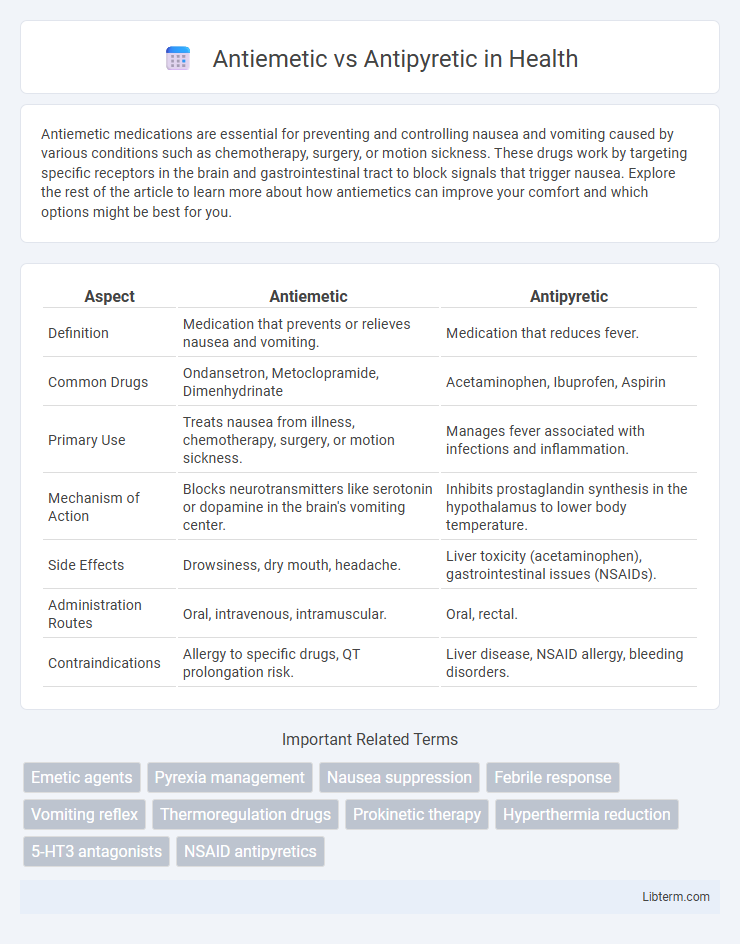Antiemetic medications are essential for preventing and controlling nausea and vomiting caused by various conditions such as chemotherapy, surgery, or motion sickness. These drugs work by targeting specific receptors in the brain and gastrointestinal tract to block signals that trigger nausea. Explore the rest of the article to learn more about how antiemetics can improve your comfort and which options might be best for you.
Table of Comparison
| Aspect | Antiemetic | Antipyretic |
|---|---|---|
| Definition | Medication that prevents or relieves nausea and vomiting. | Medication that reduces fever. |
| Common Drugs | Ondansetron, Metoclopramide, Dimenhydrinate | Acetaminophen, Ibuprofen, Aspirin |
| Primary Use | Treats nausea from illness, chemotherapy, surgery, or motion sickness. | Manages fever associated with infections and inflammation. |
| Mechanism of Action | Blocks neurotransmitters like serotonin or dopamine in the brain's vomiting center. | Inhibits prostaglandin synthesis in the hypothalamus to lower body temperature. |
| Side Effects | Drowsiness, dry mouth, headache. | Liver toxicity (acetaminophen), gastrointestinal issues (NSAIDs). |
| Administration Routes | Oral, intravenous, intramuscular. | Oral, rectal. |
| Contraindications | Allergy to specific drugs, QT prolongation risk. | Liver disease, NSAID allergy, bleeding disorders. |
Introduction to Antiemetics and Antipyretics
Antiemetics are medications designed to prevent or alleviate nausea and vomiting by targeting the central nervous system and gastrointestinal tract receptors. Antipyretics are drugs used to reduce fever through mechanisms that act on the hypothalamus to regulate body temperature. Both categories play crucial roles in symptomatic relief, with antiemetics addressing gastrointestinal disturbances and antipyretics managing elevated body temperature in various clinical conditions.
Definition: What Are Antiemetics?
Antiemetics are medications specifically designed to prevent or alleviate nausea and vomiting by targeting the brain's vomiting center or the gastrointestinal tract. They are commonly used to manage symptoms caused by motion sickness, chemotherapy, or post-surgical recovery. Unlike antipyretics, which reduce fever, antiemetics focus solely on controlling emesis and improving patient comfort.
Definition: What Are Antipyretics?
Antipyretics are medications designed to reduce fever by acting on the hypothalamus to lower the body's temperature set point. Common antipyretics include acetaminophen, ibuprofen, and aspirin, which not only reduce fever but also alleviate mild to moderate pain. They differ from antiemetics, which are used to prevent or treat nausea and vomiting.
Mechanisms of Action: How Antiemetics Work
Antiemetics work by blocking neurotransmitters or receptors in the brain and gastrointestinal tract that trigger nausea and vomiting, such as dopamine, serotonin, and histamine receptors. These drugs often target the chemoreceptor trigger zone (CTZ) and the vomiting center in the medulla oblongata to inhibit signals that induce emesis. Different classes of antiemetics, including dopamine antagonists, serotonin 5-HT3 receptor antagonists, and antihistamines, provide symptom relief by interrupting specific pathways involved in the nausea reflex.
Mechanisms of Action: How Antipyretics Work
Antipyretics reduce fever primarily by inhibiting cyclooxygenase enzymes (COX-1 and COX-2), which decreases prostaglandin E2 (PGE2) synthesis in the hypothalamus, leading to a lower set point for body temperature regulation. This action counteracts pyrogen-induced hypothalamic signaling responsible for fever development. In contrast, antiemetics target neurotransmitter receptors such as dopamine, serotonin, or histamine in the brain's vomiting center to prevent nausea and vomiting, without directly affecting body temperature.
Common Uses and Indications
Antiemetics are primarily used to prevent and treat nausea and vomiting caused by conditions such as chemotherapy, motion sickness, and postoperative recovery. Antipyretics are commonly administered to reduce fever associated with infections, inflammation, or other medical conditions. Both drug types play distinct roles in managing symptoms but target different underlying issues within patient care.
Popular Antiemetic Medications
Popular antiemetic medications include ondansetron, metoclopramide, and promethazine, which are widely used to prevent nausea and vomiting associated with chemotherapy, surgery, and motion sickness. Ondansetron functions by blocking serotonin receptors in the gut and brain, while metoclopramide enhances gastrointestinal motility and dopamine receptor antagonism. These drugs differ significantly from antipyretics such as acetaminophen and ibuprofen, which primarily reduce fever and inflammation rather than controlling nausea.
Popular Antipyretic Medications
Popular antipyretic medications such as acetaminophen (paracetamol), ibuprofen, and aspirin are widely used to reduce fever by acting on the hypothalamic heat-regulating center. These drugs also possess analgesic and anti-inflammatory properties, making them effective for a range of symptoms beyond fever control. Unlike antiemetics, which target nausea and vomiting by affecting neurotransmitters in the gastrointestinal tract and brain, antipyretics primarily focus on lowering body temperature during febrile conditions.
Side Effects and Safety Considerations
Antiemetic medications, such as ondansetron and metoclopramide, commonly cause side effects like drowsiness, headache, and gastrointestinal disturbances, with rare risks of cardiac arrhythmias. Antipyretics like acetaminophen and ibuprofen primarily may induce liver toxicity and gastrointestinal irritation, respectively, especially with prolonged use or overdose. Careful consideration of patient history, dosage limits, and potential drug interactions is crucial for ensuring the safety of these agents during fever or nausea management.
Choosing Between Antiemetics and Antipyretics
Choosing between antiemetics and antipyretics depends on the primary symptom requiring treatment: antiemetics target nausea and vomiting by blocking specific neurotransmitters or gastrointestinal signals, while antipyretics reduce fever by acting on the hypothalamic heat-regulating center to lower elevated body temperature. Effective clinical decision-making involves assessing patient symptoms, underlying causes, and potential side effects to determine whether managing nausea or controlling fever is the immediate priority. Understanding pharmacodynamics and patient history ensures the selection of appropriate medication for optimal therapeutic outcomes.
Antiemetic Infographic

 libterm.com
libterm.com